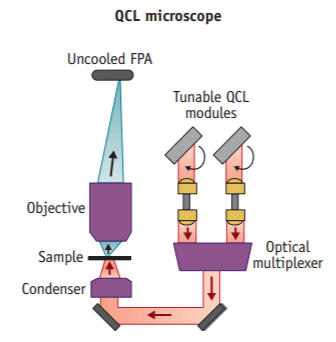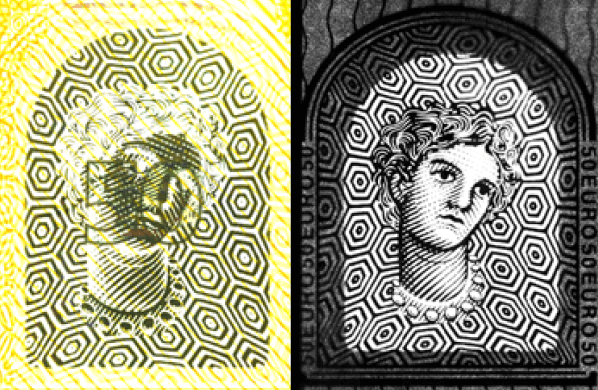The Spero® line of microscopes, based on widely tunable mid-infrared quantum cascade laser (QCL-IR) technology, is a class apart and the first and best-performing wide-field spectroscopic microscopy and imaging platform globally. It offers unparalleled speeds while receiving high-quality data.
Forged from Field Experience, Powered by Daylight™
Using Daylight’s QCL-IR systems, technology, and instrumentation experience as a foundation, DRS developed the first wide-field QCL-IR microscope in 2014 that could operate in the critical spectral fingerprint range of 5–11 µm.
Now in its third generation, Daylight has been refining and enhancing the Spero platform's performance since 2014. Spero systems have been field-tested in demanding applications, such as tissue diagnostics, cancer research, and the characterization of innovative metamaterials and environmental microplastics, and they have been successfully deployed in more than 12 countries.
QCL-IR Microscopy with Spero®
Spero-QT 340
The third-generation Spero system, the Spero-QT 340, builds on the achievements of its ground-breaking forerunners, which were introduced in 2014 and 2017, respectively. The Spero-QT 340, like its predecessors, offers unparalleled mid-IR spectroscopy and does so without the requirement for cryogenic cooling or expensive lab space. It also significantly outperforms FTIR microscopes in terms of speed, field-of-view, and spatial resolution.
Moreover, it preserves its two predecessors' high-resolution, wide-field characteristics while generating twice as much data in a tenth of the time and reaching previously unheard-of signal-to-noise ratios (SNR). The Spero-QT 340 stage has a bigger sample container, making it more compatible with microfluidic accessories and devices. It can scan up to three microscope slides.
According to Daylight's patented QCL-IR light engine, Spero-QT 340 is orders of magnitude quicker than Raman and Photothermal IR microscopes while avoiding sample auto-fluorescence and degradation by highly concentrated light sources.
Spero microscopes employ a novel wide-field, low-noise instrument design to enable new data collection modalities, including live, real-time chemical imaging and user-defined sparse discrete frequency data collection. Spero’s compact desktop footprint (dimensions in centimeters) makes it ideal for labs with limited space.
Spero-LT 340
The Spero-LT 340 is the latest addition to the Spero product line. The LT provides the same high-performance speed and resolution as the Spero-QT, but at a reduced cost for customers who want transmission and wide-field imaging (ideal for tissue imaging and microplastics). Even better, Spero-LT enables users to upgrade to Spero-QT later if necessary.
Why Quantum Cascade Laser Infrared (QCL-IR) Microscopy?
Quantum cascade lasers have orders of magnitude higher spectral brightness than incoherent light sources employed in FT-IR, for example. The Spero QCL-IR microscope fully utilizes this increased spectral brightness and a set of patented compound refractive objective lenses to illuminate hundreds of thousands of pixels simultaneously. This patented technique allows for extremely high-throughput chemical imaging without losing sensitivity.
QCL-IR spectroscopy is based on the well-acknowledged Beer-Lambert absorption concept. It is, therefore, a technique for not just spectrally fingerprinting unknown chemicals but also directly quantifying the amount of material present with great precision.
Other methods, such as Raman and Photothermal microscopy, require specific knowledge of the sample material's characteristics (e.g., scattering efficiency, thermal diffusion, etc.) to provide a quantitative estimate. Furthermore, single-point raster scanning IR reflectance instruments require decoupling the sample’s real and imaginary refractive indexes to accomplish spectral fingerprinting.
This post-processing can be heavily impacted by particle form and size, making it challenging to use existing spectral libraries.
What is the Difference Between QCL-IR Microscopy and FT-IR Microscopy?
FT-IR (Fourier Transform Infrared) has been widely employed in microscopy and spectroscopy since the late 1960s. As imaging applications require higher throughput, new technologies are displacing FT-IR.
The most significant difference between QCL-IR and FT-IR is signal-to-noise ratio (SNR) and time-to-results. FT-IR is often used with incoherent light (such as Globar®), which is quite comparable to an incandescent lightbulb. This light produces photons throughout a wide spectral range and is detected with a scanning interferometer. Since the light source is thermal, high-sensitivity detectors and liquid nitrogen are required.
Alternatively, QCL-IR microscopy employs all photons at about the same wavelength, significantly increasing spectral irradiance. This enables the user to capture a chemical picture using an uncooled focal plane array detector (FPA) 150 times quicker than a traditional FT-IR microscope with equal SNR. While FT-IR has a broader spectrum, the success of QCL-IR in several applications has demonstrated that this additional coverage is not required for many applications.
How Does QCL-IR Microscopy Work?
In a QCL-IR microscope, there are four primary subsystems: Wider spectral ranges can be covered by (1) a string of QCLs or a tunable quantum cascade laser operating together. A precise X, Y, and Z stage; (2) a set of wide-field imaging objective lenses; (3) an infrared sensitive focal plane array imager. Only a small wavelength (wavenumber) band radiates from the QCL at any given time.
The exact wavelength of the laser is accurately regulated by actuating an external cavity frequency selective element (a diffraction grating), which the device does flawlessly at a quick tuning speed (msec). In transmission imaging, the laser light is transmitted through the sample before passing through a wide-field infrared objective and being captured by the focal plane array imager.
The Spero microscope’s imager is a specialized, broadband, uncooled microbolometer camera that operates at video frame rates. Wide-field imaging provides a far larger field-of-view (FOV) than FT-IR, allowing for live, single frequency, and quick hyperspectral imaging of materials.

Image Credit: Daylight Solutions Inc.
Lasers and Coherence
Coherence is a fundamental and crucial quality of laser light, divided into two categories: temporal (frequency) and spatial.
Daylight has leveraged its almost two decades of expertise in designing and producing hundreds of QCL-IR sources and instruments to improve the Spero's overall performance and fulfill the needs of crucial applications such as tissue imaging and particle analysis.
Under the hood, the Spero platform uses some of Daylight’s most advanced and proprietary coherence control technology to suppress spatial and temporal coherence effects caused by light-sample interaction while retaining the laser source’s two main intrinsic advantages: high spectral brightness and a well-defined linear polarization state.
Preserving optical power is critical for increasing signal in light-starved applications like flowing liquid analysis and reflectance studies on weekly reflecting samples. Maintaining the polarization state is crucial when doing polarization-dependent spectroscopic research on new materials.
This technique delivers excellent images without the need for digital post-processing, as seen by the visible (left) and infrared (right) images of a 50 Euro note captured by the Spero-QT 340 microscope. These unprocessed (raw) images do not contain coherence artifacts.
Maintaining optical power is crucial to optimizing signals in light-starved applications like flowing liquid analysis or reflectance measurements on weekly reflecting samples. Maintaining the polarization state is particularly crucial when performing polarization-dependent spectroscopic studies on novel materials. The images of a 50 Euro note captured by the Spero-QT 340 microscope below show how this technology generates high-quality images without the need for digital post-processing. These unprocessed (raw) images do not have any coherence artifacts.

Visible (Left) vs QCL-IR (Right) reflection mosaic image of a 50 Euro note. Image Credit: Daylight Solutions Inc.
ChemVision™ Software for Spero
Spero systems provide ChemVision™ software as part of a comprehensive imaging solution. ChemVision allows users to examine samples at a single frequency in real-time or acquire entire hyperspectral data cubes in under a minute. Data can be exported in MATLAB or ENVI format for additional processing.
Daylight has teamed up with Epina ImageLab to develop an open and flexible programming interface for increased image analysis and data processing, and chemometrics packages are available.
Highlights
Features & Benefits
- Live, real-time infrared imaging
- High-throughput hyperspectral imaging enabled by ultra-high brightness QCL technology (>7 M spectral points per second)
- Large, flexible sample compartment
- Multiple configuration options, including extended wavelength coverage and automated polarization control
- No cryogenic cooling is needed
- Quick setup means more time for analysis
- Transmission, visible and reflection modes
- Diffraction-limited, high-sensitivity imaging with Focal Plane Array (FPA) detector
- Multiple, high-NA, large FOV imaging optics (0.7 NA and 0.3 NA)
Applications
- Materials testing and analysis
- Forensics
- Chemical detection and identification
- Microplastic Research
- Biomedical imaging of tissues, cells, and fluids
- Cancer research
- Pharmaceutical testing of tablets, powders, and liquids
- Drug discovery: API and excipient optimization and down-selection
- Protein secondary structure and aggregation testing
- Real-time reaction monitoring
Accessories & Configuration Options
- Extended Wavelength – Extend wavelength coverage to 1900-950 cm-1
- Polarization – Add rotation stage to take polarized images
- Blue Shifted – Add blue shifted range to 2225-2000 cm-1 and 1800-1200 cm-1
Product Specifications
Source: Daylight Solutions Inc.
| . |
. |
. |
| Specifications |
IR Imaging Mode |
| Parameter |
HIGH-RESOLUTION IR (0.7 NA) |
WIDE-FIELD IR (0.3 NA) |
| Wavelength Range |
Spero-LT Standard Configuration: 1750 cm-1 to 1000 cm-1
Spero-QT Standard Configuration: 1800 cm-1 to 950 cm-1
Customizable between 2300 cm-1 and 800 cm-1 |
| Image Cube Acquisition Time |
< 40 s (450 absorbance images collected at 2 cm-1 spacing) |
| Camera Array Size |
480 × 480 |
480 × 480 |
| Image Pixel Size |
1.3 µm (0.7 NA) |
4.3 µm (0.3 NA) |
| Diffraction-Limited Spatial Resolution |
< 5 µm @ λ = 5.5 µm |
< 12 µm @ λ = 5.5 µm |
| Numerical Aperture |
0.7 |
0.3 |
| Spectral Resolution |
Variable, down to 2 cm-1 |
| Minimum Detectable Signal |
< 3 mAU per scan |
| Working Distance |
> 8 mm |
> 25 mm |
| Field of View (FOV) |
650 × 650 µm (0.7 NA) |
2 mm x 2 mm (0.3 NA) |
Microplastic Analysis with QCL-IR Microscope
Microplastic Analysis with QCL-IR Microscopy. Video Credit: Daylight Solutions Inc.